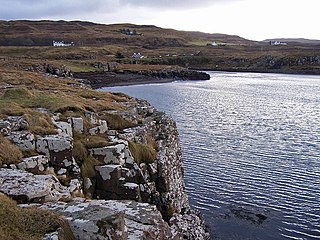
Year 1161 (MCLXI) was a common year starting on Sunday of the Julian calendar.

Year 1136 (MCXXXVI) was a leap year starting on Wednesday of the Julian calendar.

Duke of Rothesay is the main dynastic title traditionally given to the male heir apparent to the Scottish and, later, British thrones. The dukedom was created in 1398 by Robert III of Scotland for his eldest son.

Clan MacLeod is a Highland Scottish clan associated with the Isle of Skye. There are two main branches of the clan: the MacLeods of Harris and Dunvegan, whose chief is MacLeod of MacLeod, who are known in Gaelic as Sìol Tormoid ; the Clan MacLeod of Lewis and Raasay, whose chief is MacLeod of The Lewes, are known in Gaelic as Sìol Torcaill. Both branches claim descent from Leòd, a Norse-Gael who lived in the 13th century.

Dunvegan Castle is located 1 mile (1.6 km) to the north of Dunvegan on the Isle of Skye, off the west coast of Scotland. It is the seat of the MacLeod of MacLeod, chief of the Clan MacLeod. Probably a fortified site from the earliest times, the castle was first built in the 13th century and developed piecemeal over the centuries. In the 19th century the whole castle was remodelled in a mock-medieval style. The castle is built on an elevated rock overlooking an inlet on the eastern shore of Loch Dunvegan, a sea loch.

Lord of the Isles or King of the Isles (Scottish Gaelic: Triath nan Eilean or Rìgh Innse Gall) is a title of Scottish nobility with historical roots that go back beyond the Kingdom of Scotland. It began with Somerled in the 12th century and thereafter the title was held by a series of his descendants, the Norse-Gaelic rulers of the Isle of Man and Argyll and the islands of Scotland in the Middle Ages. They wielded sea-power with fleets of galleys (birlinns). Although they were, at times, nominal vassals of the kings of Norway, Ireland, or Scotland, the island chiefs remained functionally independent for many centuries. Their territory included much of Argyll, the Isles of Arran, Bute, Islay, the Isle of Man, Hebrides, Knoydart, Ardnamurchan, and the Kintyre peninsula. At their height they were the greatest landowners and most powerful lords after the kings of England and Scotland.
The Earl or Mormaer of Ross was the ruler of the province of Ross in northern Scotland.

Clan MacNeacail, sometimes known as Clan MacNicol, is a Scottish clan long associated with the Isle of Skye. Tradition states that, early in its history, the clan held the Isle of Lewis, as well as extensive territory on the north-western mainland. The earliest member of the clan on record is one 14th century John "mak Nakyl", who is recorded amongst Edward I of England's powerful West Highland supporters during the Wars of Scottish Independence. John Barbour's 1375 epic, The Brus, suggests that by 1316, the clan had switched allegiance to Robert I, and made a decisive intervention in the new theatre of Anglo-Scottish conflict in Ireland. The marriage of an heiress to the MacLeods of Lewis brought a severe loss of lands and power in the following generation, forcing the clan chiefs to relocate to the surviving estates on Skye. However, the MacNeacails retained local significant influence: serving, according to tradition, as members of the Council of the Lords of the Isles and as custodians of the cathedral church of the Western Isles at Snizort. In the 17th century, members of the clan began to Anglicise their surname from the Scottish Gaelic MacNeacail to various forms, such as Nicolson. Today the English variants of the Gaelic surname are borne by members of the clan as well as members of unrelated Scottish families, including the Lowland Clan Nicolson.
John is a common English name and surname:

The Battle of Glendale was fought on the Inner Hebridean Isle of Skye, between the MacDonalds of Sleat and the MacDonalds of Clanranald, against the MacLeods of Harris and Dunvegan and the MacLeods of Lewis. According to MacLeod tradition preserved in the early 19th century, the battle was fought in about the year 1490; yet it has been recently suggested that the battle more likely took place sometime after 1513. MacLeod tradition records that the battle was the 'most tremendous battle' that the clan ever fought—although the clan was victorious, it never fully recovered from its severe losses. MacLeod tradition relates how the MacDonalds originally had the upper hand during the conflict, but when the MacLeod's sacred Fairy Flag was unfurled the MacLeods gained heart and won the battle.

Alasdair Crotach MacLeod is considered to be the 8th Chief of Clan MacLeod. He was the son of the 7th Chief of Clan MacLeod, William Dubh, and succeeded his father in 1480, following William Dubh's death at the Battle of Bloody Bay. He was the first MacLeod chief not to be buried on the island of Iona.
Þórkell Þórmóðarson is a character from the mediaeval Hákonar saga Hákonarsonar, a kings' saga composed in the last half of the 13th century. The saga relates that in about the year 1230, a Norwegian-Hebridean fleet sailed down through the Hebrides, where it attacked certain islands there, and proceeded on to the Isle of Man. As the fleet made its way southward through the Hebrides, several members fought a battle with Þórkell at Vestrajǫrðr, near Skye. The exact location of Vestrajǫrðr is unknown, although Loch Bracadale, Loch Dunvegan, and Loch Snizort, all located on the western coast of Skye, have been proposed as possible locations. According to the saga, Þórkell and two of his sons were slain in the encounter, however a third son, named Þórmóðr, managed to escape with his life. Early the next year, the fleet headed northwards through the Hebrides back home. When it approached the Isle of Lewis, a man named Þórmóðr Þórkelson fled for his life, leaving behind his wife and possessions to be taken by the marauding fleet.